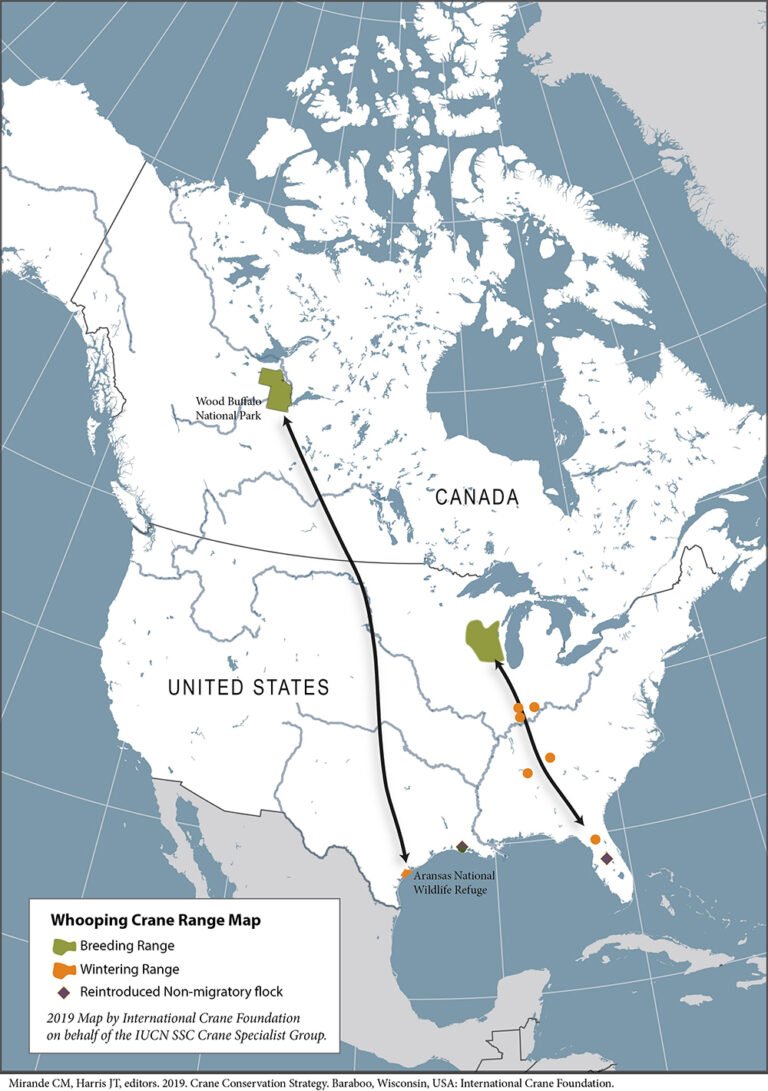Whooping Crane (photo by Ted Thousand/International Crane Foundation).
The Whooping Crane is a large white bird with a black mustache-like face mask, featherless red patch on the crown of their head and black wing tips, and standing at five-feet tall, it is the tallest bird in North America. It is also one of the rarest and most endangered birds. Pre-European expansion, there were an estimated 10,000 Whooping Cranes across the fertile wetlands and prairies of North America. Historically these cranes would have occupied a massive range spanning the majority of the United States and Canada and would spend their summer months breeding as far north as the artic and wintering as far south as central Mexico. However, by the 1940s Whooping Cranes reached near extinction when only 20 remained in a single population that migrated between Wood Buffalo National Park in Canada and Aransas National Wildlife Refuge in Texas. This near extinction was largely driven by four factors: unregulated hunting, egg collecting, the millinery trade, and habitat loss.
Whooping Crane flyways (image by International Crane Foundation).
Today, due to increased conservation efforts by the International Crane Foundation and our partners as well as robust legal protections, there are more than 650 wild Whooping Cranes across four distinct populations. Three of those populations were reintroduced to the United States, and one is known as the Eastern Migratory Population (EMP). The EMP was first reintroduced to wetlands in Wisconsin in 2001 and to date this population hosts almost 80 Whooping Cranes. From April through November, Whooping Cranes in the EMP are found in Wisconsin just north of Madison Audubon’s Faville Grove and Goose Pond sanctuaries at Necedah and Horicon National Wildlife Refuges.
In Wisconsin, Whooping Cranes have just completed nesting for the year and as a result five wild-hatched chicks joined the EMP this summer. When the cranes are around 3-5 years old, they will find a single partner to mate with, presumably for life, and begin breeding, nesting, and eventually raising chicks together. Whooping Cranes build their nests over water for greater protection from predators, a large mound of dried grass with a small depression in the center where they lay one or two baseball-sized brown speckled eggs. The pair takes turns sitting on those eggs for around 30 days until a chick, called a colt, hatches. The parents raise this colt, sometimes two, for the next year. Needless to say, Whooping Crane reproduction is slow, so to help the EMP grow, the International Crane Foundation also releases fledglings into the population. This summer seven chicks hatched in captivity and are expected to be released into the EMP.
A wild-hatched chick (photo by Hillary Thompson/International Crane Foundation).
The return of Whooping Cranes to Wisconsin and the gradual growth of this population suggests a promising future for Whooping Cranes everywhere. However, they continue to face threats to their populations due to urban expansion, wetland conversion, poaching, threats of a Sandhill Crane hunting season, human-wildlife conflicts, and expansions of high voltage transmission lines which increase collision risks. To ensure that Whooping Cranes remain a significant part of the Wisconsin landscape for many years to come, they need your help.
Fortunately, there are many ways you can protect Whooping Cranes in Wisconsin, including:
Safely looking for Whooping Cranes—know how to identify Whooping Crane adults and juveniles (see ID guide below) and give them their space. Remember to stay at least 2 football fields away from cranes at all times.
Respecting the spaces where Whooping Cranes live—keep wetlands free of litter, support wetland protections, stay on the trail, respect private property, and only park in designated parking areas.
Reporting any poaching or harassment of Whooping Cranes to 1-800-847-9367
Reporting banded Whooping Cranes to www.bandedcranes.org
Talking to your friends and family about Whooping Cranes and wetlands in Wisconsin
Heading to our website www.savingcranes.org to learn more about cranes and plan a visit to our headquarters in Baraboo, WI. The International Crane Foundation is open to visitors May 1-October 31, 9am-5pm every day of the week!
Large water birds ID Guide (image by International Crane Foundation).
Written by Stephanie Schmidt, Whooping Crane Outreach Coordinator for the International Crane Foundation and former Faville Grove Sanctuary intern
Cover photo: A white Whooping Crane is seen from above sitting on a nest in the midst of a wetland habitat (photo by Tom Lynn/International Crane Foundation).









